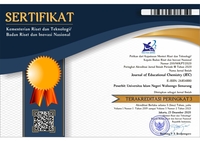Developing Interactive Augmented Reality Learning Media to Introduce Chemistry Laboratory Equipment in Senior High School
DOI:
https://doi.org/10.21580/jec.2025.7.1.21090Keywords:
instructional media, laboratory equipment, augmented realityAbstract
This research aimed to describe the validity or feasibility value of developing a game-based augmented reality learning application to introduce chemical laboratory equipment. The application developed was AR-LAB (Augmented Reality Laboratory), combining augmented reality technology with quizzes. This research employed development research using Richey and Klein's theory, which contains three steps: planning, production, and evaluation. The results show that the product's validity by material and media experts was 91.67% and 91.67%, respectively, in the very good category. The teacher assessment provided an average score of 112.4 from the ideal maximum score of 120, with an ideal level reaching 93.60% in the very good category. Meanwhile, testing by ten students obtained the maximum score in the very good category. The successfully developed media has the advantage of introducing laboratory equipment in three dimensions that are affordable and easy for students to learn about chemical laboratory equipment.
Downloads
References
Andrian, R., and Ardiansyah, A. (2020). Pelatihan Pengembangan Media Pembelajaran Berbasis Augmented Reality (AR) Bagi Guru-Guru SMA Provinsi Lampung. Jurnal Pengabdian Kepada Masyarakat (JPKM) Tabikpun 1(1): 55–62. https://doi.org/10.23960/jpkmt.v1i1.7.
Husniah, A., and Raekha, A. (2022). Modul Matematika dengan Model Pembelajaran Problem Based Learning untuk Memfasilitasi Kemampuan Penalaran Matematis Siswa. Mosharafa: Jurnal Pendidikan Matematika 11(2): 327–38.
Krisnandry, F., and Bahri, S. (2020a). Implementasi Teknologi Augmented Reality (Ar) Pada Aplikasi Smart Book Reaksi Redoks dan Elektrokimia Menggunakan Metode Marker Based Tracking Berbasis Desktop” Coding Jurnal Komputer dan Aplikasi 8(1). https://doi.org/10.26418/coding.v8i1.39212.
———. (2020b). Implementasi Teknologi Augmented Reality (Ar) Pada Aplikasi Smart Book Reaksi Redoks dan Elektrokimia Menggunakan Metode Marker Based Tracking Berbasis Desktop. Coding Jurnal Komputer dan Aplikasi 8(1). https://doi.org/10.26418/coding.v8i1.39212.
Lubis, A. H., and Dasopang, M. D. (2020). Pengembangan Buku Cerita Bergambar Berbasis Augmented Reality untuk Mengakomodasi Generasi Z. Jurnal Pendidikan: Teori, Penelitian, dan Pengembangan 5(6): 780. https://doi.org/10.17977/jptpp.v5i6.13613.
Ma’ruf, M. T., and Primandari, P. N.. (2024). Aplikasi Pembelajaran Simpul dan Sandi pada Pramuka Tingkat Penggalang Menggunakan Augmented Reality Berbasis Mobile. Jurnal Teknologi dan Informasi 14(1): 11–23. https://doi.org/10.34010/jati.v14i1.11124.
Pradana, D. K., Supandi, S., & Wardani, T. I. (2022). Rancang Bangun Media Pengenalan Alat Laboratorum Kimia Berbasis Mobile Augmented Reality. Jipetik: Jurnal Ilmiah Penelitian Teknologi Informasi & Komputer, 3(2), 81-87. https://doi.org/10.26877/jipetik.v3i2.12784
Ramadhan, A. F., Putra, A. D, & Surahman, A. (2021). Aplikasi Pengenalan Perangkat Keras Komputer Berbasis Android Menggunakan Augmented Reality (Ar). Jurnal Teknologi dan Sistem Informasi 2(2): 24–31. https://doi.org/10.33365/jtsi.v2i2.840.
Rizti, Y., Angga, R., & Kholiq, A. (2021). Pengembangan Media Augmented Reality Untuk Melatih Keterampilan Berpikir Abstrak Siswa SMA pada Materi Medan Magnet. PENDIPA Journal of Science Education 6(1): 80–87. https://doi.org/10.33369/pendipa.6.1.80-87.
Rustamana, A., Agustin, N., Pisma, V. A., & Syams, A. W. A. (2023). Pengembangan dan Pemanfaatan Media Cetak: Storyboard. Cendikia: Jurnal Pendidikan dan Pengajaran 1(4): 1–6. https://doi.org/10.572349/cendikia.v1i4.415.
Sandi, M. S. (2021). Aplikasi Pengenalan Huruf Hijaiyah Berbasis Augmented Reality dengan Menggunakan Buku Marker Iqro. Strata1, Universitas Teknokrat Indonesia. https://doi.org/10/5/daftar_pustaka17311062.pdf.
Saputra, W. D., and Kurniawati, Y. (2021a). Desain Media Pembelajaran Berbasis Android pada Materi Praktikum Pengenalan Alat Laboratorium Kimia Sekolah Menengah Atas. Journal of Natural Science and Integration 4(2): 268–76. https://doi.org/10.24014/jnsi.v4i2.12068.
———. (2021b). Desain Media Pembelajaran Berbasis Android pada Materi Praktikum Pengenalan Alat Laboratorium Kimia Sekolah Menengah Atas. Journal of Natural Science and Integration 4(2): 268–76. https://doi.org/10.24014/jnsi.v4i2.12068.
Shahnaz, Y. E., and Tresnani, N. (2021). “Pengembangan Game Edukasi Matematika untuk Memfasilitasi Kemampuan Pemahaman Konsep Materi Jaring-Jaring Kubus. In Prosiding Seminar Pendidikan Matematika dan Matematika. Vol. 3.
Suciliyana, Y., and Rahman, L. A. (2020). Augmented Reality Sebagai Media Pendidikan Kesehatan untuk Anak Usia Sekolah. Jurnal Surya Muda 2(1): 39–53. https://doi.org/10.38102/jsm.v2i1.51.
Widayanti, R., and Nur’aini, K. D. (2020). Penerapan Model Pembelajaran Problem Based Learning untuk Meningkatkan Prestasi Belajar Matematika dan Aktivitas Siswa. Mathema: Jurnal Pendidikan Matematika, 2(1): 12–23. https://doi.org/10.33365/jm.v2i1.480.
Yana, M., Elvinawati, & Amir, H. (2021). Pengembangan Video Pembelajaran Pengenalan Alat-Alat Laboratorium dan Implementasinya pada Aplikasi Google Classroom. Alotrop, 5(2): 183–90. https://doi.org/10.33369/atp.v5i2.17140.
Zamhari, M., Subekti, Z. A., Setiawati, E. M., & Kangkamano, T. (2022). Development of Puzzles for Chemical Laboratory Glassware Integrated with Islam as A Learning Medium. Journal of Natural Science and Integration, 5(1), 57-67. http://dx.doi.org/10.24014/jnsi.v5i1.16896
Downloads
Published
How to Cite
Issue
Section
License
Copyright (c) 2025 Journal of Educational Chemistry (JEC)

This work is licensed under a Creative Commons Attribution-NonCommercial-ShareAlike 4.0 International License.
The copyright of the received article shall be assigned to the journal as the publisher of the journal. The intended copyright includes the right to publish the article in various forms (including reprints). The journal maintains the publishing rights to the published articles.
Authors are permitted to disseminate published articles by sharing the link/DOI of the article at the journal. Authors are allowed to use their articles for any legal purposes deemed necessary without written permission from the journal with an acknowledgment of initial publication to this journal.

This work is licensed under a Creative Commons Attribution-NonCommercial-ShareAlike 4.0 International License.


